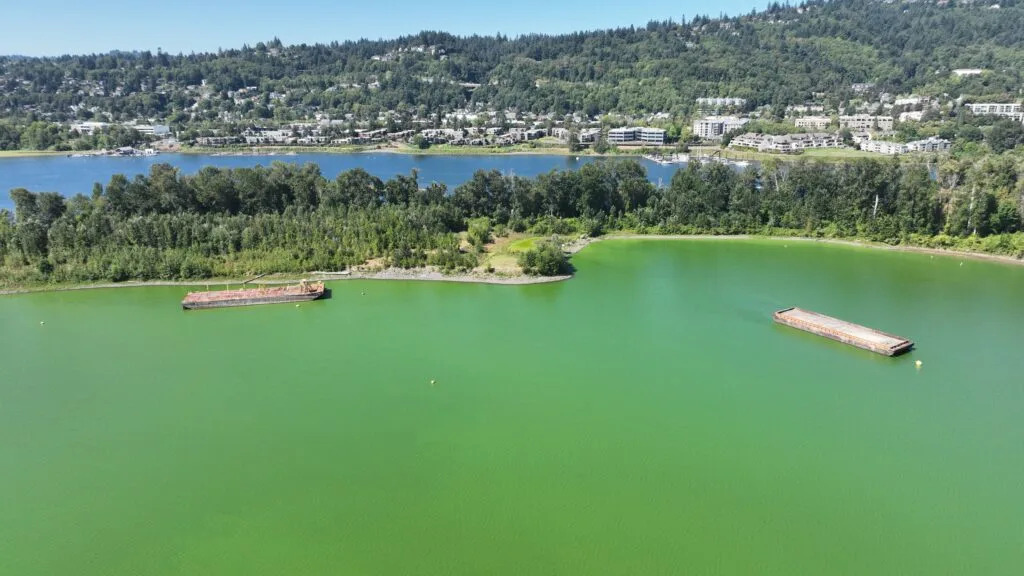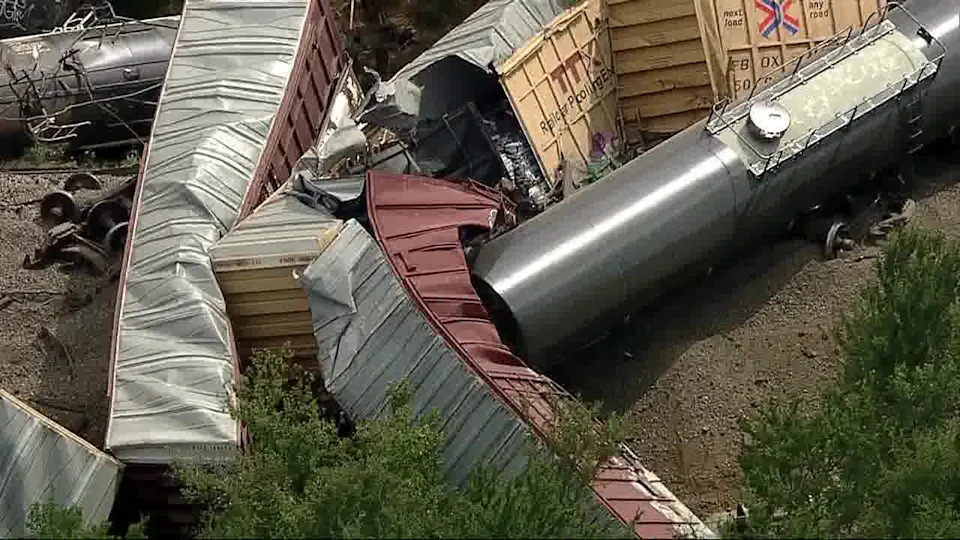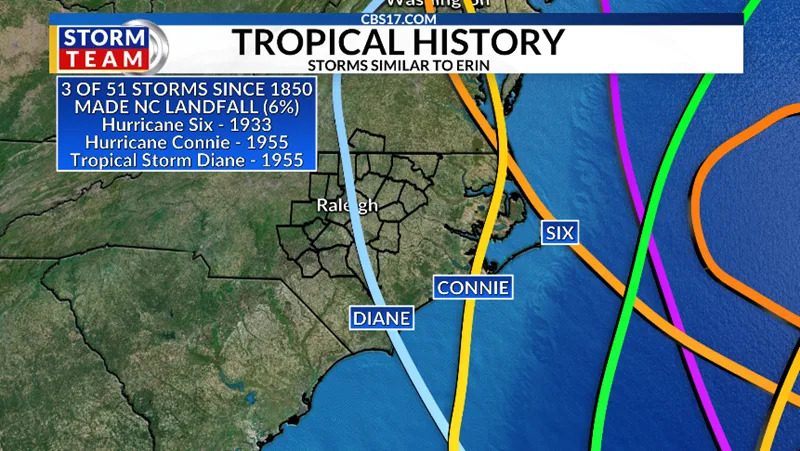
The algae bloom forming around Ross Island Lagoon in the Willamette River on Monday morning. (Photo courtesy of Eagle Eye Droneography)
The thick, green layer of toxin-producing algae currently growing on the Willamette River south of downtown Portland is not just a public health issue but a reminder to Willie Levenson of “a total bureaucratic failure.”
That’s for a couple of reasons. First, Levenson, founder of the Portland-based nonprofit Human Access Project, said he alerted the Oregon Health Authority of the bloom Friday, Aug. 8, but the agency didn’t issue a public health advisory warning people and pets to stay away until Monday night. On Wednesday, the agency extended the advisory to cover roughly 15 miles of the Willamette downriver to Kelley Point Park, where it nearly meets the Columbia River.
“They let the whole weekend go by with people in that water,” Levenson said. Cyanobacteria produced by the algae can cause headaches, diarrhea, nausea, vomiting and fever if inhaled or ingested.
Erica Heartquist, a spokesperson for the Oregon Health Authority, said in an email that they cannot issue an advisory until staff at the Oregon Department of Environmental Quality or a “water body manager with water quality expertise” provides a visual assessment and supporting documentation of a harmful algae bloom.
The other reason Levenson called it a bureaucratic failure: He has tried for several years to get state and local agencies, and the governor’s office, to help him address the now-annual algae blooms that grow from the hot and stagnant waters of the Ross Island Lagoon and spread down the main stem of the Willamette River. The lagoon, created by the U.S. Army Corps of Engineers in the 1920s and made deeper by the Ross Island Sand and Gravel company mining gravel from the river, has created a “140-acre pond inside a river,” according to Levenson.
The solution that he and Oregon State University scientists identified after six years of study is to design and dig a channel through the lagoon’s embankment and let the water move freely again.
Oregon lawmakers had the chance to support the design of the project with a $1 million investment from the state’s general fund during the latest legislative session that wrapped in June. And at first, they did.
House Bill 3314 passed unanimously from the House Agriculture, Land Use, Natural Resources and Water Committee in March.
“It was a 9-0 vote with a kiss and a hug,” Levenson said.
But the bill died unceremoniously in the Joint Ways and Means Committee without a vote. Without the funding, Levenson is stuck finding private money to design the channel and eventually build it while the toxic algae blooms continue year-after-year unabated. He already spent two years fundraising $500,000 through grants from nonprofits and local and tribal governments to cover the first 30% of the planning process. The rest of the plan hinged on getting money from the legislature.
State Rep. Mark Gamba, D-Milwaukie, who sponsored the bill, said it died like many others in the Ways and Means committee: “Because there was no money.”
“We were $500 million short from a normal operating budget,” he said. “A lot of bills like this that weren’t a lot of money, that were going to solve real problems, didn’t get the money they needed.”
Gamba said it’s likely he’ll try again to get funding for the project in 2027. Until then, Levenson will be left to find private money to fund the work.
Levenson is in disbelief that Gov. Tina Kotek and state agencies won’t “own the problem” on the arterial waterway of Oregon’s largest city.
“Why is a one-and-a-half person nonprofit put in a role to drive a solution to this problem? Everything’s been a bake sale and we’ve had no help from the state,” he said. “It’s not an option not to solve this.”
Levenson said he’s been discussing these issues with Kotek’s Regional Solutions Office for the last two years to little avail. The office is meant to bring state agencies and the private sector together to tackle specific issues across “11 regions” of the state.
“They’ve been giving me placated answers. I’ve lost faith in the Regional Solutions process,” he said.
Anca Matica, a Kotek spokesperson, said the Regional Solutions Office and the Governor’s Office “have met with and continue to meet with various stakeholders,” including the Oregon Health Authority, Department of Environmental Quality, Department of Agriculture, and the Department of State Lands to coordinate on public health advisories around the algae blooms.
A hole in the river
Matica said paying to fix the algae bloom problem also lies with the Ross Island Sand and Gravel company, which has created the deep, warm water lagoon where the algae blooms originate.
Ross Island used to be one of a complex of four islands. In the 1920s, the U.S. Army Corps of Engineers moved the earth on two of the islands around to create an embankment connecting them to divert water and make a deeper shipping channel in the river, as well as to make it more accessible to industry. The two islands combined created the U-shaped Ross Island, but the new embankment stopped the natural flow of the river between the islands and the lagoon became a stagnant pond in the river.
In 1926, the Ross Island Sand and Gravel Co. established itself on the island and started excavating millions of tons of gravel from the river to make cement, creating a large hole in the river until 2001. The combination of the gravel excavation, the man-made lagoon around it, hot summers and pollution from nearby cities has led to the perfect conditions for cyanobacteria and algal blooms to grow in the area.
The Ross Island Sand and Gravel Co. though no longer operational, is under orders from the Department of State Lands to undertake reclamation work to refill the hole the company left in the river from decades of excavation. As part of that, it’s possible the company could offer to pay for some of the channeling work.
The company is currently facing a $2.9 million fine from the Oregon Department of State Lands for failing to comply with the terms of its agreement to refill the Ross Island lagoon. They could choose to direct 80% of the fine to a Supplemental Environmental Project such as the lagoon channeling.
Under a 2024 settlement with the Northwest Environmental Defense Center, which sued the company over perpetuating the toxic blooms, Ross Island Sand and Gravel is required to block the lagoon so algae can’t spread after the state has issued an advisory, something Levenson said is also a bureaucratic failure because the algae has typically spread well beyond the lagoon by the time the state issues an advisory.
Officials in charge of the billion-dollar Portland Clean Energy Community Benefits Fund, made up of revenue from a 1% tax on large retail businesses in the city, declined to fund project planning and implementation because it was not reducing carbon dioxide emissions, according to Levenson.
SUBSCRIBE: GET THE MORNING HEADLINES DELIVERED TO YOUR INBOX





Comments